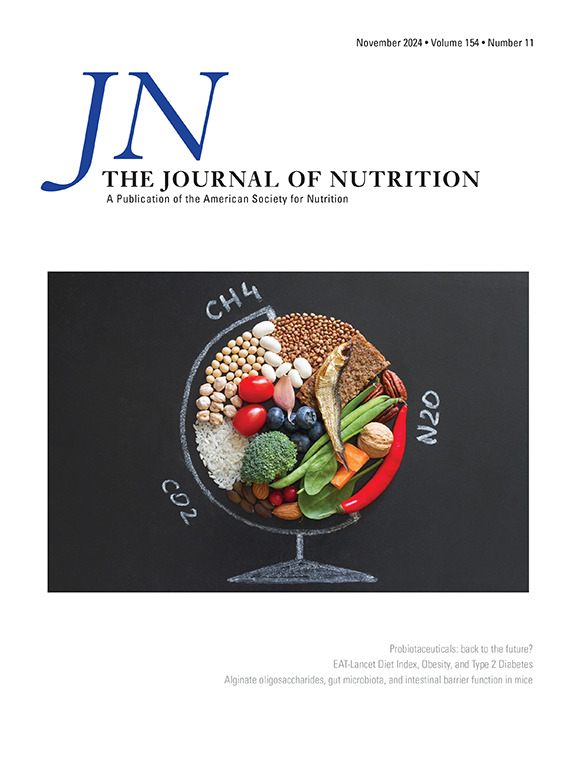Excess Folic Acid Exposure Increases Uracil Misincorporation into DNA in a Tissue-Specific Manner in a Mouse Model of Reduced Methionine Synthase Expression
IF 3.7
3区 医学
Q2 NUTRITION & DIETETICS
引用次数: 0
Abstract
Background
Folate and vitamin B12 (B12) are cofactors in folate-mediated 1-carbon metabolism (FOCM), a metabolic network that supports synthesis of nucleotides (including thymidylate [dTMP]) and methionine. FOCM impairments such as a deficiency or imbalance of cofactors can perturb dTMP synthesis, causing uracil misincorporation into DNA.
Objective
The purpose of this study was to determine how reduced expression of the B12-dependent enzyme methionine synthase (MTR) and excess dietary folic acid interact to affect folate distribution and markers of genome stability in mouse tissues.
Methods
Heterozygous Mtr knockout mice (Mtr+/–) model the FOCM-specific effects of B12 deficiency. Folate accumulation and vitamer distribution, genomic uracil concentrations, and phosphorylated histone H2AX (γH2AX) immunostaining were measured in male Mtr+/+ and Mtr+/− mice weaned to either a folate-sufficient control (C) diet (2 mg/kg folic acid) or a high folic acid (HFA) diet (20 mg/kg folic acid) for 7 wk.
Results
Exposure to the HFA diet led to tissue-specific patterns of folate accumulation, with plasma, colon, kidney, and skeletal muscle exhibiting increased folate concentrations compared with control. Liver total folate did not differ. Although unmetabolized folic acid (UMFA) increased 10-fold in mouse plasma with HFA diet, UMFA accounted for <0.2% of total folate in liver and colon tissue. Exposure to HFA diet resulted in a shift in folate distribution in colon tissue with higher 5-methyl-THF and lower formyl-THF than in control mice. Mtr heterozygosity did not impact folate accumulation or distribution in any tissue. Mice on HFA diet exhibited higher uracil in genomic DNA and γH2AX foci in colon. Similar differences were not seen in liver.
Conclusions
This study demonstrates that folic acid, even when consumed at high doses, does not meaningfully accumulate in mouse tissues, although high-dose folic acid shifts folate distribution and increases uracil accumulation in genomic DNA in colon tissue.
在蛋氨酸合成酶表达减少的小鼠模型中,过量叶酸会以组织特异性方式增加尿嘧啶在 DNA 中的错结合。
背景:叶酸和维生素 B12(B12)是叶酸介导的一碳代谢(FOCM)中的辅助因子,这一代谢网络支持核苷酸(包括胸苷酸或 dTMP)和蛋氨酸的合成。辅因子缺乏或失衡等 FOCM 障碍会扰乱 dTMP 的合成,导致尿嘧啶错误地结合到 DNA 中:本研究的目的是确定依赖 B12 的蛋氨酸合成酶(MTR)的表达减少与过量叶酸如何相互作用,从而影响小鼠组织中叶酸的分布和基因组稳定性标记。在雄性Mtr+/+和Mtr+/-小鼠断奶后食用叶酸充足的对照(C)饮食(2毫克/千克叶酸)或高叶酸(HFA)饮食(20毫克/千克叶酸)7周后,对叶酸积累和维生素A分布、基因组尿嘧啶水平和磷酸化组蛋白γH2AX免疫染色进行了测定:与对照组相比,血浆、结肠、肾脏和骨骼肌中的叶酸浓度都有所增加。肝脏总叶酸没有差异。虽然小鼠血浆中的未代谢叶酸(UMFA)在摄入氢氟膳食后增加了 10 倍,但在肝脏和结肠组织中,UMFA 占总叶酸的比例不到 0.2%。与对照组小鼠相比,接触氢氟膳食导致结肠组织中叶酸分布发生变化,5-甲基-THF含量更高,甲酰-THF含量更低。Mtr杂合子不影响叶酸在任何组织中的积累或分布。食用 HFA 食物的小鼠结肠中基因组 DNA 和磷酸化组蛋白 H2AX(γH2AX)病灶中的尿嘧啶含量较高。肝脏中未见类似差异:本研究表明,尽管高剂量叶酸会改变叶酸的分布并增加结肠组织基因组 DNA 中尿嘧啶的积累,但即使高剂量摄入叶酸,也不会在小鼠组织中产生有意义的积累。
本文章由计算机程序翻译,如有差异,请以英文原文为准。
求助全文
约1分钟内获得全文
求助全文
来源期刊

Journal of Nutrition
医学-营养学
CiteScore
7.60
自引率
4.80%
发文量
260
审稿时长
39 days
期刊介绍:
The Journal of Nutrition (JN/J Nutr) publishes peer-reviewed original research papers covering all aspects of experimental nutrition in humans and other animal species; special articles such as reviews and biographies of prominent nutrition scientists; and issues, opinions, and commentaries on controversial issues in nutrition. Supplements are frequently published to provide extended discussion of topics of special interest.
 求助内容:
求助内容: 应助结果提醒方式:
应助结果提醒方式:


